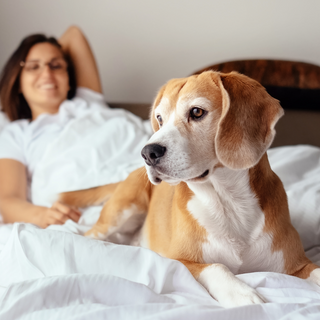Planning your enrichment garden
It is time to start planning your enrichment garden for the coming year: what goes where, what worked last year, and which areas can be improved upon.
The aim is to create a space that is safe and that provides interest and freedom for our dogs to fulfil their natural need to sniff and explore. These simple pleasures produce the feel-good hormone dopamine, lowering stress levels and improving wellbeing.
All the herbs suggested are safe for dogs, should they consume or brush up against them.
Many dogs can be stressed, anxious, over-excited or reactive on the lead, so just having a space – however small – where they can relax, lower their heads, stretch their back muscles and fulfil some of their basic but essential needs is so valuable.
Dogs love to find somewhere peaceful to just sit and watch the world go by and enjoy the interesting scents carried on the breeze.
We are very visual creatures by nature but for dogs, it’s all about the scent. With 300 million receptors and each nostril designed to take in different information, dogs are in the premier league when it comes to their ability to “read” their surroundings.

An ideal way of enriching our dogs’ lives is by making full use of our outdoor space. This can include creating a restful area, growing dog-safe herbs, adapting a section of the garden for exploring and scent work, and growing some vegetables to enrich the diet while also providing for wildlife, particularly the pollinators.
There are some materials that make gardening easier but are certainly not dog-friendly or good for wildlife. Things to avoid include cocoa bean mulch, coconut shells and bark chippings, which are poisonous if eaten and can also cause intestinal blockage.
If you decide to dig rotted manure into your beds, be aware that this can be attractive to some dogs. Manure will cause an upset tummy if eaten and if your dogs explore it, they will bring the smell and residues into the house, which is not ideal! You may need to section that area off until the manure is well rotted down.
It goes without saying that artificial fertiliser, pesticides and slug pellets have no place in a child, pet or wildlife-friendly garden. Dogs will be in close contact with any chemicals and will not only breathe in the toxins but also absorb them through their paws.
Pots, containers & raised beds
Tall herb and strawberry pots are nice to use as you can fit many plants in a small area. I grew wild strawberries last year and the dogs just helped themselves as the berries gradually became ripe.
You can get creative and make a small path edged with branches or stones and plant herbs alongside it, or perhaps make a spiral or wheel from pebbles and fill in the gaps with your chosen herbs.
Raised beds can be kept low, allowing the dog to step in and out. You could also attach a strong, short ramp if needed. The higher versions are great for growing veg and protecting young plants until they are more mature and robust.
Texture and cover
It is important to take your dog’s personality and any health issues into account when planning the area.
If your dog loves to explore and hunt for treats, then an area with some form of plant cover will be ideal for hiding snuffle mats, interactive toys or even just an egg box with treats in. This will provide endless fun and is something you can do together.
You can also incorporate any raised areas or make obstacles with railway sleepers, straw bales, fallen branches and logs to create an interactive area for the keen explorer. Sturdy, non-slip ramps can be used for agile dogs that like to go up to another level, but just make sure it is well within their capabilities of getting up and down safely.
If you have a very elderly, disabled or possibly a blind dog, you need to keep the terrain as easy as possible and concentrate more on stimulating their sense of smell and creating an interesting but stress-free environment. For dogs with these specialised needs, sometimes the garden is the only outdoor space they can comfortably explore.
Many elderly dogs love to worship the sun but make sure they are not left unattended as they may overheat and have difficulty getting up in order to move to shade. A large beach parasol or gazebo can be ideal to create shade while still allowing them to relax outside.
Slight variations in texture underfoot can help the blind dog to steer away from areas that may not be suitable, and they will soon learn an easy route. This can be something as simple as laying a strip of slate chippings, pebbles or gravel as edging. Or you can use non-slip mats or even a thin strip of sand as a guide to prepare them for a change of direction, incline or a step, for example.
You could also use a ground cover chamomile called Chamaemelum nobile to create a fragrant walkway. Or, if space allows, grow an area of chamomile lawn, which releases its fragrance when the leaves are trodden on.

Lawns
If you are lucky enough to have a grassy area, then you have a perfect opportunity to create an environment to nurture wildlife and provide a great sensory space for your dog. They will spend ages sniffing blades of grass and scent trails left by insects, birds and wildlife, as well as nipping the tops out of the new grass shoots as they appear.
I have a dog whose greatest pleasure seems to be a daily roll on her back in the grass whatever the weather, something she never once attempted when we had a six-month stay in a house with a synthetic lawn.
For those dogs that spend the vast majority of their lives walking on concrete, tarmac or synthetic materials such as laminate or carpets, this is a vital way to reconnect them with the earth beneath their feet.
What to plant
There are many herbs that are safe for our dogs to eat or come into close contact with through directly touching, sniffing, nibbling or digging at the roots. There are also a few that should be avoided or planted well out of reach; one example would be rue, which can cause skin blisters. For this reason, I have chosen to concentrate on the safe ones. These herbs have a lot to offer, and you can be confident about having them in the garden.
It is worth mentioning that many people believe that rosemary can trigger epilepsy. There have certainly been studies on essentials oils possibly being a trigger, but little research has been conducted on the actual herb causing this effect. However, if you do have a dog with epilepsy, grow your rosemary in tall pots or an area that is inaccessible to the dog to be on the safe side. You can then enjoy the gorgeous scent and taste without any concern.
Must-haves in the herb garden, for flavour and nutritional value, are parsley, dill, fennel, sage, thyme, oregano and calendula.
For aroma and calming properties, the top-five herbs to grow would have to be lavender, lemon balm, lemon verbena, chamomile and pineapple sage.
Mint is so useful and provides scent, flavour and beautiful small flowers that insects adore. The only downside is that mint is very invasive and its creeping roots can soon take over large areas, so it is best confined to pots.
Wheat and barley grass are ideal to plant in pots and place in an area that is easily accessible to your dog, then they can help themselves should they want to. I also found that my dogs would sometimes eat lemon grass in the summer when it was at its most fragrant.

Vegetables to share
You can grow a selection of vegetables in a relatively small area by making use of raised beds or deep pots and by thinking about the space you can use vertically and growing plants that love to climb, such as green beans. You can also attach containers to walls and trellis.
Suitable veggies that you can share with your dog and that are easy to grow include courgette, squash, cabbage, spinach, lettuce and kale. And always plant lots of parsley!
- Choosing a selection results in a full page refresh.


